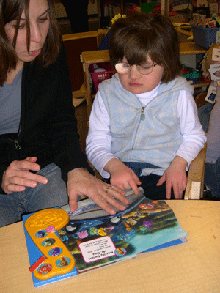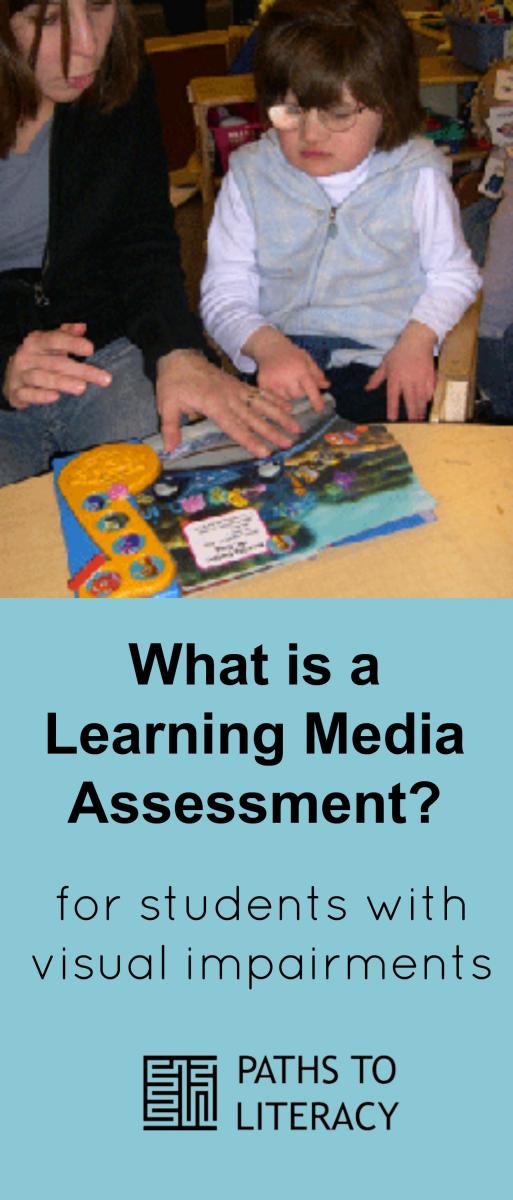Overview of Learning Media Assessment
Overview of Learning Media Assessment

The Learning Media Assessment (LMA) offers a framework for selecting appropriate literacy media for a student who is visually impaired. A Functional Vision Evaluation (FVE), which is also known as a Functional Vision Assessment (FVA), should be done first, in order to determine what the student is able to see and how he or she is using his or her vision. These two assessments should be used together to help to guide the team decision about the best instructional medium for a given student, such as braille, print, dual media (both print and braille), auditory, tactile, pictures or some combination.
- What is a Learning Media Assessment?
- What does the LMA assess?
- When should the LMA be used?
- Why perform the LMA?
- What are the goals of the LMA?
- Additional Information
Learning Media Assessment...
-
is an assessment for selecting the appropriate literacy media for students with visual impairments. "Literacy media" refers to the way in which students access the general education curriculum and includes braille, print, auditory strategies, objects, and pictures.
-
offers teachers and educational teams a framework or decision-making process for the selection of literacy media.
-
provides a decision and monitoring tool for both conventional and functional literacy for students with visual impairments.
-
involves a team process and the collation of medical, educational, family and student-supplied data to make informed decisions.
What exactly does the LMA assess?
The LMA assesses a student's learning style, or the way in which he or she uses vision, touch, hearing, and other senses, either singularly or in combination, to gain access to information. This is where LMA has often been misunderstood. One of the key things that is assessed is the student's learning style, which is particularly useful when working with young children with visual impairments.
When should the LMA be done?
The LMA evaluation contributes important information in determining eligibility as a student with a visual impairment. It helps identify the impact of visual impairment on access to learning materials. It should be updated annually and/or as visual functioning changes. In some states, the LMA is a required element of eligibility evaluations.
This evaluation can be used academically for students who are in the general education curriculum and proceeding along an academic track. However, it is also useful when evaluating children with more complex disabilities in looking at functional literacy and other educational media decisions.
The LMA takes a broad definition of learning media, which includes literacy tools for reading and writing in some form, such as using drawing or expressive communication. Some teachers of students with visual impairment (TVIs) only look at the braille/print decision, but the Learning Media Assessment goes much further than that to look at the preferred sensory channels of ALL students.
Why perform Learning Media Assessments?
The primary reason to perform a Learning Media Assessment is to ensure that all children have access to literacy and to education. In addition, Braille Bills require the determination of literacy media exist at both the Federal and State level. These various Braille bills assume that Braille is the modality to be used unless otherwise demonstrated through appropriate assessment. Learning Media Assessment offers the tool to make that determination and monitor it over time.
For instance, the Legislative Changes in IDEA (Individuals with Disabilities Education Act), which was just re-authorized, states the following about braille:
- "Consideration of Special Factors: The IEP Team also shall -
(iii) In the case of a child who is blind or visually impaired, provide for instruction in Braille and the use of Braille unless the IEP Team determines, after a determination of the child's reading and writing skills, needs and appropriate reading and writing media (including an evaluation of the child's future needs for instruction in Braille or the use of Braille), that instruction in Braille or the use of Braille is not appropriate for the child." 34 CFR Section 300.346 (a) (2) (iii) and 20 U.S.C. 1414(d)
LMA's Primary Goals, as outlined by Koenig and Holbrook:
- "Examine efficiency with which student gathers information from various sensory channels"
- Types of general learning media the student uses, or will use to accomplish learning tasks
- "The literacy media the student will use for reading and writing" (Koenig, Holbrook, 6)
Using the Learning Media Assessment to Guide Educational Planning
Once a Learning Media Assessment has been performed, the team should gather to weigh various considerations in order to determine what medium is most appropriate for each student. Some students may learn better through a tactile mode and thus braille may be recommended, while others have sufficient vision to learn to read print. Still others may benefit from dual media, in which they learn both print and braille. For other students auditory channels may be the most appropriate.
What form should be used for the LMA?
The following are available for purchase:
-
The FVLMA Kit: Functional Vision and Learning Media Assessment, American Printing House for the Blind (APH)
Sample LMA Reports
For more information about Learning Media Assessment, see also:
By Eva Lavigne and Ann Adkins, TSBVI Outreach; See/Hear (Spring 2003)
Parents and teachers of students with visual impairments often have questions about how the choice is made regarding a student's literacy medium. They express concerns about whether a student should be primarily a print reader or a Braille reader, and want to know how and when decisions about reading media are made. This article explains what a Learning Media Assessment is, and how it is used in planning for an individual student.
Dr. Hatlen discusses how the choice is made among learning media.
- Learning Media Assessment, Family Connect

This material was originally based on a presentation by Tom Miller, now retired, and formerly at Perkins School for the Blind.
